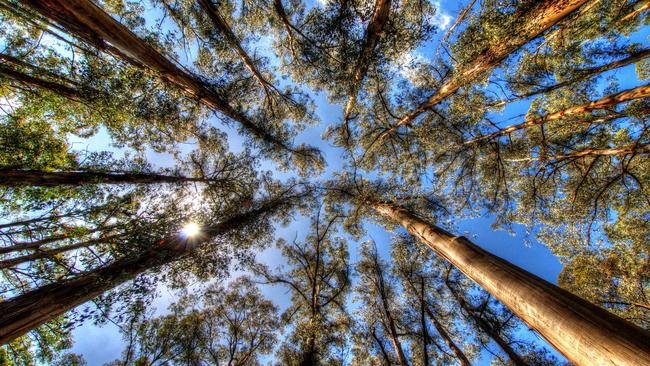In praise of trees


This weekend is a national celebration of our trees. It was Schools Tree Day on Friday, National Tree Day this Sunday. Our most iconic tree, of course, is the eucalypt with its 900-odd species of most glorious variety. Sequencing of the eucalypt genome from the beautifully named rose gum (Eucalyptus grandis) has shown that the species harks back a mighty 109 million years, when dinosaurs roamed the Earth.
Eucalypts – the world’s tallest flowering plants – are wonders. Their singular blossoms, immortalised by May Gibbs, have no petals; the entire bloom of their happy little skirts is made up of a multitude of stamens clasped by a central bud. The leaves change over a tree’s lifetime – when young they’re held horizontally to maximise the surface area to collect sunlight, but as the tree matures the stalk of the leaf twists, making it vertical so it isn’t exposed to as much radiation. Some species shed large branches, brutally quickly, to save water during droughts. They’re known as widow makers because of the number of people killed by falling branches in colonial days. (Arguably the most harrowing moment in Australian literature occurs in Seven Little Australians. It involves a gum tree and it haunted my childhood.)
Eucalypts are all shapes and sizes and inhabit most areas of Australia’s gloriously diverse terrain. Favourites: the shin-bone beauty of the ghost gum stark against the red of the Central Australian rocks; the gracious shade of the river red gum in the still of the midday heat; the freshly laden snow gum glittering with its burden under a tall blue sky; and the joyous pops of colour the West Australian flowering gums gift us every year. All were enough to move home to from foreign lands.
Former forest worker Peter Wohlleben demonstrated in his book The Hidden Life of Trees the ecological wonder of the tree. Trees need each other, he argues, just as humans do. Wohlleben believes that trees are social beings; that they experience pain, that tree parents live with their children, that they make room for each other with their canopies. He says that most individual trees of the same species growing in the same stand are connected to each other through their root systems, which result in nutrient exchanges and a helping of each other in times of need. He believes sick trees are nurtured to recover and keep growing. A group of a similar species creates a micro climate that protects them, “an ecosystem that moderates extremes of heat and cold”. They store water and generate humidity, so the tree as a collective can grow old. Wohlleben describes a delicate process of accommodation, a politeness in the tree world, particularly towards your own species. The whole is greater than the parts, which is why isolated trees live much shorter lives; the collective maintains the individual. It’s a beautiful concept.
This weekend, tip your hat to a tree. My favourite is a local ghost gum; its trunk looks like a twist of two, fused over years. Oh, the wonder of these mighty gifts standing tall among us. Pause and note a favourite. Perhaps even plant one. The good people behind National Tree Day can point you in the right direction. Just Google it, type in your postcode, and see what activity comes up in your area.



Imagine a world without trees. In some places on Earth humans live exactly this desolation – pity the people with no bowers of singing green to walk under and no soaring canopies to look up through. Trees are medicine and tonic. Life-giving, shade-giving, de-stressing and reviving, and how lucky we are to live alongside their grace. These giants among us bring much joy. We see them, smell them, hear them, feel their magnitude. My heart always flinches at the sight of a logging track with its trunks stacked high – oh, what those shaggy and shorn cylinders once were.